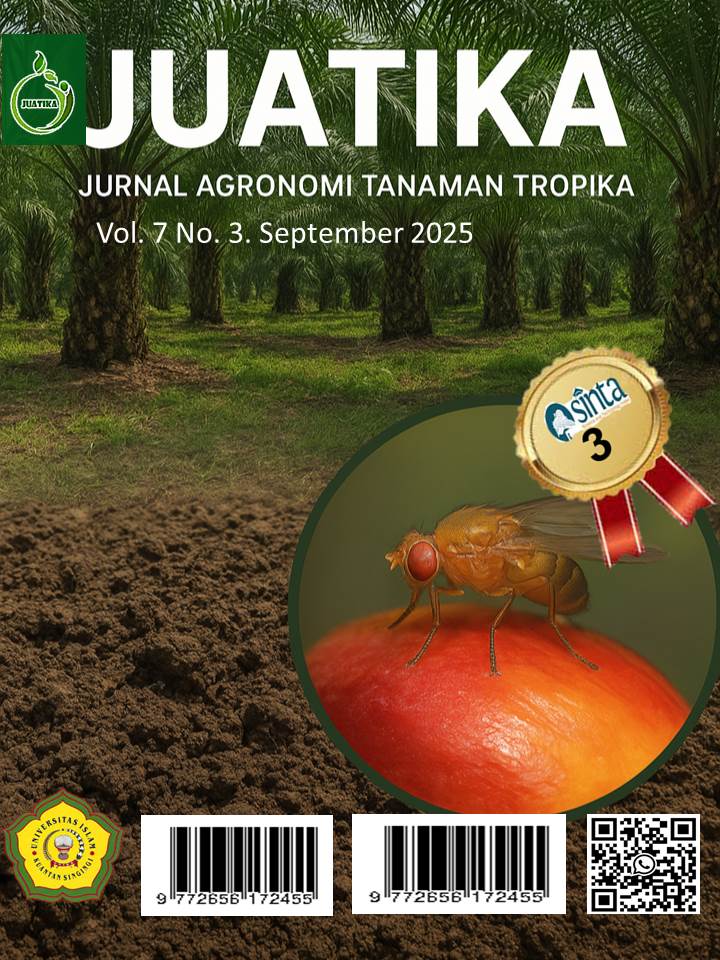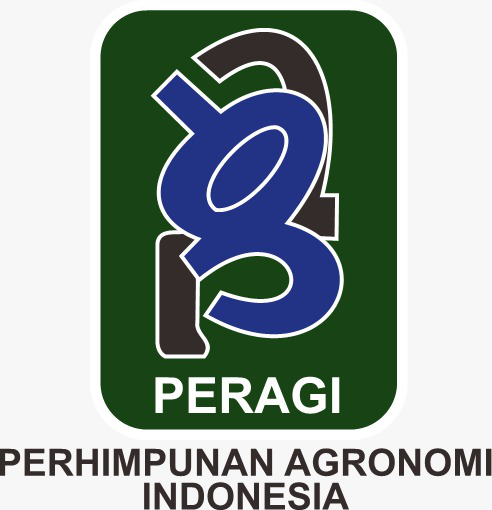Analysis of C-Organic, Nitrogen, and C/N Ratio Contents in Oil Palm Plantations Soil Owned by the People of Pulau Binjai Village, Kuantan Mudik District, Kuantan Singingi Regency, Riau Province
Abstract
Land conversion from rubber plantations to oil palm plantations is increasingly common in Indonesia, including in Pulau Binjai Village, Kuantan Mudik District, Kuantan Singingi Regency, Riau Province. Land preparation for oil palm plantations can affect soil fertility, particularly nutrient content. This study aims to evaluate the nutrient content in one-year-old oil palm plantations. The methods used in this study included surveys and laboratory analyses. Soil sampling was conducted at 10 locations using purposive random sampling at a depth of 20 cm, with 5 locations sampled using the grid method and 5 using the disc method. Each sample location consisted of 5 subsamples, which were then composited. The results showed that the soil pH in the grid ranged from 5.96 to 6.48 (acidic category), while in the disc it ranged from 6.2 to 6.88 (acidic to neutral category). The organic carbon content in the grid ranged from 2.61 to 3.74 (medium to high category), and in the plate from 2.82 to 4.28 (medium to high category). The total nitrogen content in the grid ranged from 0.20 to 0.25 (low to medium category), while in the plate it ranged from 0.21 to 0.29 (medium category). The C/N ratio in the grid ranged from 11.16 to 17.00 (medium to high category), and in the plate from 10.44 to 14.75 (low to medium category). The key findings of this research include the identification of organic carbon and nitrogen content in the soil, which enables recommendations for the application of organic and nitrogen fertilizers in the study area.
Downloads
References
Angela, A. D., Suyatno, A., & Imelda. (2025). Analisis faktor-faktor yang mempengaruhi konversi lahan karet menjadi kelapa sawit di Kecamatan Sekadau Hulu. Warta Perkaretan, 44(1), 55–64. https://ejournal.puslitkaret.co.id/index.php/wartaperkaretan/article/view/1093/691
Anggliani, M. (2021). Teknis budidaya tanaman kelapa sawit (Elaeis guineensis Jacq) di Divisi B Kebun Pangarungan, PT. Asam Jawa. Laporan Praktek Kerja Lapangan I dan II. Politeknik Lembaga Pendidikan Perkebunan. https://repository.polteklpp.ac.id/id/eprint/516/1/Teknis%20Budidaya%20Tanaman%20Kelapa%20Sawit%20(%20Elaeis%20guineensis%20Jacq%20)di%20Divisi%20B%20Kebun%20Pangarungan,%20PT%20Asam%20Jawa..pdf
Basuki, & Sari, V. K. (2019). Efektifitas dolomit dalam mempertahankan pH tanah Inceptisol perkebunan tebu Blimbing Djatiroto. Buletin Tanaman Tembakau, Serat & Minyak Industri, 11(2), 58–64. https://doi.org/10.21082/btsm.v11n2.2019.58-64
Gulo, N. A., Mendrofa, A. I. P., Lase, B. V. L., Mendrofa, C. F., Telaumbanua, I. V., & Laia, I. S. (2024). Kurangnya unsur hara pada tanaman cabai merah serta pemeliharaannya. Tumbuhan: Publikasi Ilmu Sosiologi Pertanian dan Ilmu Kehutanan, 1(3), 13–20. https://doi.org/10.62951/tumbuhan.v1i3.112
Gurusinga, A. U., Dewi, N., & Rosnita. (2022). Analisis prospektif peremajaan kelapa sawit (Elaeis guineensis Jacq) pola swadaya di Kabupaten Rokan Hulu. Jurnal Sosial Ekonomi Pertanian, 18(1), 55–66. https://doi.org/10.20956/jsep.v18i1.19024
Gusriati, Sumarno, W., & Sudarso, J. (2023). Analisis pendapatan petani sawit dari alih fungsi lahan sawit di Desa Pondok Baru Kecamatan Selagan Raya Kabupaten Mukomuko. Jurnal Agri Sains, 7(1), 11–17. https://doi.org/10.36355/jas.v7i1.1006
Hady, N. A., Manfarizah, M., & Basri, H. (2023). Kajian sifat fisika tanah pada berbagai kelas umur tanaman kelapa sawit di Kecamatan Langsa Baro Kota Langsa. Jurnal Ilmiah Mahasiswa Pertanian, 8(4), 770–782. https://doi.org/10.17969/jimfp.v8i4.28031
Hakim, N., & Hermansah, H. (2025). Dasar-dasar ilmu tanah (Edisi ke-2). Andalas University Press.
Hamid, I. (2019). Pengaruh pemberian pupuk NPK Mutiara terhadap pertumbuhan dan produksi tanaman jagung (Zea mays L.). Jurnal BIOSAINSTEK, 2(1), 9–15. https://doi.org/10.52046/biosainstek.v2i01.311
Haq, A., Santosa, E., & Ritonga, A. W. (2024). Jarak tanam dan dosis pupuk nitrogen mempengaruhi pertumbuhan dan hasil padi ketan grendel (Oryza sativa L. var. glutinosa). Buletin Agrohorti, 12(1), 21–29. https://doi.org/10.29244/agrob.v12i1.51579
Istiqomah, N., Adriani, F., & Rodina, N. (2018). Kandungan unsur hara kompos eceng gondok yang dikomposkan dengan berbagai macam PGPR. Rawa Sains: Jurnal Sains STIPER Amuntai, 8(1), 1–10. https://doi.org/10.36589/rs.v8i1.79
Khusrizal, Nasruddin, Muliana, O. S. Z., & Erliana, N. (2022). Penggunaan limbah organik cair pabrik dan industri tahu dalam meningkatkan kualitas fisikokimia dan stok karbon tanah Haplustepts. Jurnal Ilmiah Pertanian, 19(2), 107–117. https://doi.org/10.31849/jip.v19i2.9884
Kurniasih, Jubaedah, D., & Syaifudin, M. (2019). Pemanfaatan kapur dolomit [CaMg(CO₃)₂] untuk meningkatkan pH air rawa lebak pada pemeliharaan benih ikan patin siam (Pangasius hypophthalmus). Jurnal Akuakultur Rawa Indonesia, 7(1), 1–12. https://doi.org/10.36706/jari.v7i1.9018
Kurniawan, C. A., Afriani, M., Maulana, A., & Gusmawartati. (2021). Studi literatur: Uji kemampuan konsorsium isolat bakteri selulolitik dalam mempercepat dekomposisi tandan kosong kelapa sawit. Jurnal Ilmu dan Lingkungan, 23(1), 28–32. https://doi.org/10.29244/jitl.23.1.28-32
Lumbanraja, L., Amalia, R. H., Sarno, Dermiyati, Hasibuan, R., Agustina, W., Satgada, C. P., Zulkarnain, E., & Awang, T. R. (2019). Perilaku pertukaran amonium dan produksi tebu (Saccharum officinarum L.) yang dipupuk anorganik NPK dan organik pada pertanaman tebu di tanah Ultisol Gedung Meneng. Journal of Tropical Upland Resources, 1(1), 1–18. http://repository.lppm.unila.ac.id/14129/1/Jamalam%20L.%20Raja.pdf
Lutfiah, I., Sulistyawati, & Pratiwi, S. H. (2021). Pengaruh dosis nitrogen terhadap pertumbuhan dan hasil tanaman terung ungu (Solanum melongena L. var. Hibrida F1 Antaboga). Jurnal Agroteknologi Merdeka Pasuruan, 5(1), 1–6. https://jamp-jurnal.unmerpas.ac.id/index.php/jamppertanian/article/view/51/48
Nopsagiarti, T., Okalia, D., & Marlina, G. (2020). Analisis C-organik, nitrogen dan C/N tanah pada lahan agrowisata Beken Jaya. Jurnal Agrosains dan Teknologi, 5(1), 11–18. https://doi.org/10.24853/jat.5.1.11-18
Nopsagiarti, T., Saputri, M. A., & Refiani, T. P. (2025). Analisis pH, C-organik, N-total dan rasio C/N tanah lahan perkebunan kelapa sawit di Desa Logas Kabupaten Kuantan Singingi. Jurnal Agro Indragiri, 10(2), 21–26. https://doi.org/10.32520/jai.v4i1
Permatasari, G. Y., Kesumadewi, A. G. I., & Suwastika, A. A. N. G. (2019). Dinamika amonium dan nitrat lahan sawah Latosol pada budidaya konvensional padi lokal dan hibrida di Subak Jatiluwih. Agrotrop, 9(2), 135–145. https://doi.org/10.24843/AJoAS.2019.v09.i02.p04
Pratama, B. A., Sabrina, T., & Sembiring, M. (2019). Uji efektivitas beberapa jenis dekomposer pada beberapa jenis bahan kompos. Jurnal Pertanian Tropik, 6(1), 142–152. https://doi.org/10.32734/jopt.v6i1.3054
Purba, T., Ningsih, H., Junaedi, P. A. S., Junairiah, B. G., & Firgiyanto, R. (2021). Tanah dan nutrisi tanaman. Yayasan Kita Menulis. https://dosen.unmerbaya.ac.id/file/content/2022/03/tanah_dan_nutrisi_tanaman_gunawan.pdf
Putra, D. A., Adam, D. H., Mustamu, N. E., & Harahap, F. S. (2022). Analisis status nitrogen tanah dalam kaitannya dengan serapan N oleh tanaman padi sawah di Kelurahan Ujung Bandar, Kecamatan Rantau Selatan, Kabupaten Labuhan Batu. Jurnal Pertanian Agros, 24(1), 387–391.
Putra, I., & Jalil, M. (2015). Pengaruh bahan organik terhadap beberapa sifat kimia tanah pada lahan kering masam. Jurnal Agrotek Lestari, 1(1), 27–34. https://doi.org/10.35308/jal.v1i1.433
Rozi, M. B., & Prastia, B. (2019). Pengaruh dosis kapur dolomit terhadap pertumbuhan dan hasil tanaman kelapa sawit (Elaeis guineensis Jacq) TM 15 pada Ultisol di Kabupaten Bungo. Jurnal Sains Agro, 4(1), 1–9. https://doi.org/10.36355/jsa.v4i1.243
Salam, A. K. (2020). Ilmu tanah. Global Madani Press. http://repository.lppm.unila.ac.id/30475/1/2020%20Ilmu%20Tanah.pdf
Sari, R., & Prayudyaningsih, R. (2015). Rhizobium: Pemanfaatannya sebagai bakteri penambat nitrogen. Info Teknis EBONI, 12(1), 51–64. https://media.neliti.com/media/publications/491847-none-fdf4c732.pdf
Sari, T., Rafdinal, & Linda, R. (2017). Hubungan kerapatan tanah, karbon organik tanah dan cadangan karbon organik tanah di kawasan agroforestri tembawang Nanga Pemubuh Sekadau Hulu Kalimantan Barat. Protobiont, 6(3), 263–269. https://doi.org/10.26418/protobiont.v6i3.22492
Siringoringo, H. H. (2014). Peranan penting pengelolaan penyerapan karbon dalam tanah. Jurnal Analisis Kebijakan Kehutanan, 11(1), 175–192. https://media.neliti.com/media/publications/29285-ID-peranan-penting-pengelolaan-penyerapan-karbon-dalam-tanah.pdf
Wasir, A. P. S., Tamod, Z. E., & Sondakh, T. D. (2022). Kondisi kesuburan kimia tanah di lahan agrowisata nanas Kabupaten Bolaang Mongondow. Jurnal Agroekoteknologi Terapan, 3(2), 439–447. https://doi.org/10.35791/jat.v3i2.44864
Zega, I. C., & Lase, N. K. (2025). Potensi Rhizobium dalam meningkatkan efisiensi fiksasi nitrogen untuk kesuburan tanah: Kajian literatur. Hidroponik: Jurnal Ilmu Pertanian dan Teknologi dalam Ilmu Tanaman, 2(1), 86–94. https://doi.org/10.62951/hidroponik.v2i1.228
Ziliwu, Y. M., & Lase, N. K. (2025). Peran mikroorganisme dalam proses degradasi bahan organik. Hidroponik: Jurnal Ilmu Pertanian dan Teknologi dalam Ilmu Tanaman, 2(1), 132–141. https://doi.org/10.62951/hidroponik.v2i1.235
Copyright (c) 2025 Chairil Ezward, Tri Nopsagiarti, A. Haitami, Elfi Indrawanis, Gusti Marlina, Haris Susanto, Infitria, Nikmatul Farisya Imanda

This work is licensed under a Creative Commons Attribution 4.0 International License.
Authors who publish with Jurnal Agronomi Tanaman Tropika (JUATIKA) agree to the following terms:
Authors retain copyright and grant the Jurnal Agronomi Tanaman Tropika (JUATIKA) right of first publication with the work simultaneously licensed under a Creative Commons Attribution License (CC BY 4.0) that allows others to share (copy and redistribute the material in any medium or format) and adapt (remix, transform, and build upon the material for any purpose, even commercially) with an acknowledgment of the work's authorship and initial publication in Jurnal Agronomi Tanaman Tropika (JUATIKA).
Authors are able to enter into separate, additional contractual arrangements for the non-exclusive distribution of the journal's published version of the work (e.g., post it to an institutional repository or publish it in a book), with an acknowledgment of its initial publication in Jurnal Agronomi Tanaman Tropika (JUATIKA). Authors are permitted and encouraged to post their work online (e.g., in institutional repositories or on their website) prior to and during the submission process, as it can lead to productive exchanges, as well as earlier and greater citation of published work.







 More Information
More Information



